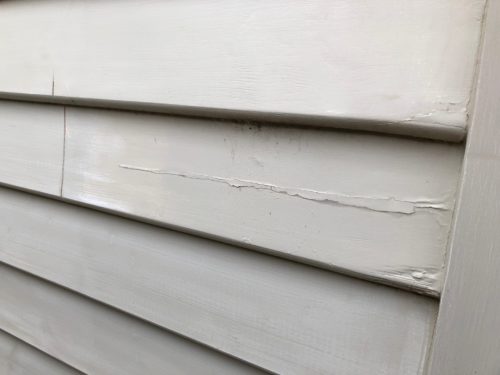The reason this occurs is that at some stage in the paint cycle of the house, the timber surfaces would have been painted with an enamel (oil-based) paint. The down side of enamel paints is that, once cured it becomes quite hard and inflexible thus becoming brittle. All exterior timber surfaces will expand and contract as we move through the different weather seasons, but because the blisters appear in the warmer months and because one of the properties of enamel paints is a lack of flexibility, the movement in timber will shear or pull the paint away from the timber surface causing poor adhesion.
Another reason blistering occurs in paint is that because enamel paints are hard and brittle, over time enamel paints develop tiny cracks in the surface and as a result allows moisture to enter. When the timber surfaces are painted with undercoats or two top coats, the moisture becomes trapped and when the hot sun and heat is shone onto the painted surface the enclosed moisture tries to escape by moving to an area where the paint has lost adhesion with the timber, thus resulting in blistering.
You will also notice that of an evening when the sun is not shining onto the painted surfaces, the blisters will disappear. Also if you pop one of the blisters you will notice that you will see the timber underneath all the layers of paint, reaffirming that it is the original enamel paints that have lost adhesion to the timber not the new acrylic paints that have been applied.
How do you fix the problem? Well basically you have to strip the effected/ blistered areas back to bare timber and start the preparation from scratch. That is, filling nail holes and timber cracks and knots, sanding, priming and undercoating before the new top coats are applied. This is the only way to avoid the problem and unfortunately this a problem that faces the painter and their prospective client, because it can become expensive and very labour intensive and quite often the client will not want to pay for this.
The picture below illustrates another example of timber movement that causes splits in the timber edges, especially around nails. As a result of the movement, the paint has pulled away from the surface thus allowing moisture and water to seep in and as a result the paint begins to lift in those areas resulting in peeling paint over time.

It is recommended to strip the old exterior paint before applying the new acrylic top coats, but be aware that most old enamel paints may contain lead and the safe removal of the old paint is best left to an accredited safe lead removal contractor. If you have any concerns about your exterior painted surfaces then it is important to discuss your concerns with your painting contractor.



